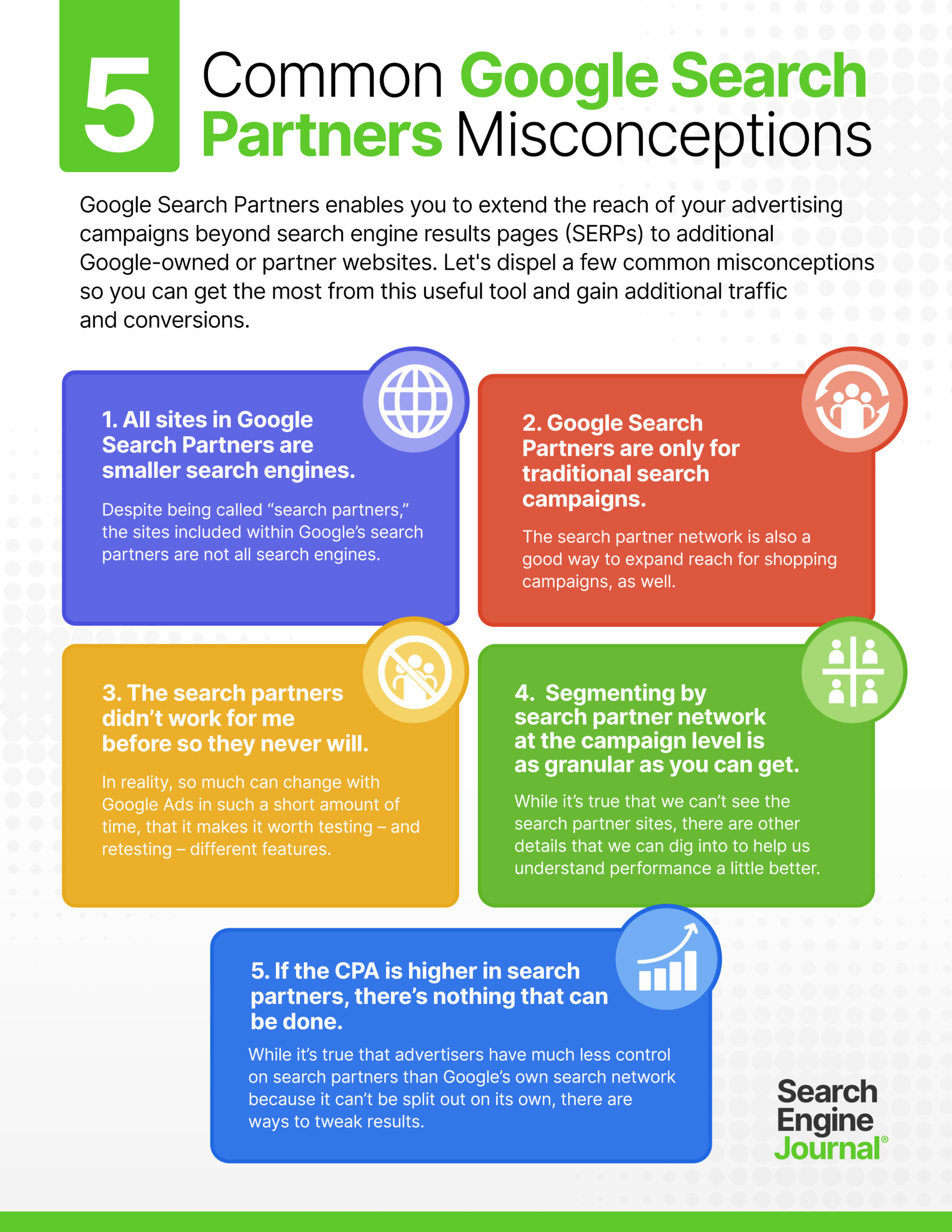To use Google Search Partners, or not? That is the question.
Maybe not for Hamlet, but certainly for paid search professionals everywhere.
When you create a new search campaign, you’re automatically opted into the display network and search partners by default.
This allows your ads to appear on properties owned by Google (like YouTube and Google Maps), companies they have partnered with (e.g., Amazon and Walmart), and other websites that sell ad placements.
Google doesn’t publish a complete list of search partners, but websites that show these ads must opt-in and in return, they receive a share of the advertising profits.
By extending your advertising campaigns beyond search engine results pages (SERPs) and onto additional websites that Google owns or partners with, the Google Search Partners network can be a useful tool for gaining additional traffic and conversions.
It allows you to place ads more widely and stand out from the crowd.
But it’s not without its drawbacks, which is why the commonly accepted best practice for most advertisers is to disable it.
The biggest downside is the lack of transparency and control. There is limited data about where your ads are displayed and you can’t prevent ads from displaying in placements with poor performance or controversial content.
Google’s Search Partners network also includes parked domains that can drain your budget without your ads ever being seen by real users.
You also have limited control over ad auctions, as bid modifiers cannot be used.
So, how do you make the search partners network work for your campaigns?
Let’s look at some of the ways you can use the Google Search Partners network to gain visibility and control while making sure it’s performing as well as possible.
5 Common Misconceptions About Google Search Partners
Before we jump into management tips, we should first cover exactly what the Search Partner network is and some of the common misconceptions.

Misconception 1: All Sites Included Are Smaller Search Engines
Despite being called “search partners,” the sites included within Google’s search partners are not all search engines.
In fact, Google defines its Search Partners as:
“Sites in the Search Network that partner with Google to show ads.
Search partners extend the reach of Google Search ads to hundreds of non-Google websites, as well as YouTube and other Google sites.
On search partners sites, your ads can appear on search results pages, on site directory pages, or on other pages related to a person’s search.”
Misconception 2: The Search Partners Are Only For Traditional Search Campaigns
Actually, the search partner network is also a good way to expand reach for shopping campaigns, as well.
Misconception 3: Just Because The Search Partners Didn’t Work Before Means They Never Will
In reality, so much can change with Google Ads in such a short amount of time, that it makes it worth testing – and retesting – different features.
In October 2018, Google launched Smart Bidding for search partner sites, with the goal of maximizing conversions at a similar CPC to Google Search.
This alone could make it worth another test if your campaigns had excluded search partners prior to that adjustment.
Misconception 4: The Most Granular Insight You Can Get Into Search Partners Is By Segmenting By Search Partner Network At The Campaign Level
While it’s true that we can’t see the search partner sites, there are other details that we can dig into, to help us understand performance a little better.
Keep reading, we’ll revisit this.
Misconception 5: If The CPA Is Higher In Search Partners, There’s Nothing That Can Be Done
While it’s true that advertisers have much less control on search partners than Google’s own search network because it can’t be split out on its own, there are ways to tweak results.
We just have to get a little bit more creative about how we go about it.
Low-Hanging Fruit On The Search Partner Network
If you haven’t tested the search partners before, or you’re wary of it for any reason, you might want to first aim for the low-hanging fruit.
Find your targets with the highest intent and test the search partners there first.
Your Brand Campaign
Many advertisers max out their brand campaigns if they have the budget.
The search partner network can be a great way to drive some additional volume for those searches.
Your RLSA Campaigns
Because these people have already been to your site, they’re more qualified than any ol’ searcher.
In this situation, I like to think of audiences as training wheels; it’s a good way to test without much risk.
Getting To The Bottom Of The Performance Delta
If you’re finding conversion volume in search partners but not at a return that is cost-effective, the first step is to try to identify the root cause of the poor performance so we can determine the best course of action.
Running a few quick reports can easily shine some light on problem areas.
Review Keyword Performance
Often if the search network isn’t performing, it could be because some of the terms are too broad and aren’t performing as well as some of the long-tail terms.
You can segment your keyword list by search network the same way that you would segment campaign performance.
Now, you can easily see which keywords are doing well on search partners and which are spending money without return – or converting but at a higher than acceptable cost.
Review Match Types
Another common reason that search partners might not perform as well is because performance might be skewed across match types.
By downloading the segmented keyword report, you can easily pivot the data to see how each of the match types performs across the networks.
Often, but not always, search partners tend not to perform as well on broad match keywords.
Review Device Usage
You might find that search partners don’t perform as well on mobile devices.
Segmenting your device data by search partners lets you zero in this. You might find that one device performs much better than the other.
Steps You Can Take To Improve Performance on Google Search Partners
Unfortunately, with Google’s search partners, you can’t see specific placements.
Therefore you also can’t exclude specific placements, target specific placements, or add bid modifiers to placements – or even the network in general.
That limits your options a bit but here’s what you can do:
Segment Out Your Campaigns By Match Type
If you find that the search partners are performing well on one or two match types, segment your campaigns out and then opt only for the match types that proved to perform well historically into search partners.
I would add a caveat that there would have to be enough volume from the search partners to warrant saving.
Only you can decide what that threshold is for your account, but I wouldn’t suggest a large-scale restructure for a small amount of volume.
Segment Out Your Campaigns By Device
If you find that the search partners are performing well on one device and not the other, you might consider splitting up the campaign and keeping only certain devices opted into search partners.
Again, this is really only warranted if there is proven volume worth saving.
Segment Out Your Campaigns By Match Type
If certain keywords perform really poorly on search partners, consider segmenting them out – but only if it’s not at a risk to a high volume of Google search conversions.
Segmenting Out An RLSA Campaign
If you find that certain audiences (first-party or third-party) added as observation-only perform better than the searchers outside of said audiences, you might consider breaking out an RLSA campaign and opting search partners in while keeping them out of the non-RLSA campaign.
Duplicating A Campaign Just For Search Partners
I know what you’re thinking: “Wait, what? We can’t bid on just search partners.”
You’re right!
However, you can duplicate your campaign and set the bids much lower than your current campaign so that Google’s search network won’t pick them up.
The good thing about this is that it doesn’t disrupt the performance of the keywords on the Google search network. You have to be careful, though.
If you pause things in the Google search campaign, that traffic may start re-routing to your second campaign.
Other Things To Consider
In Feb 2021, Google Ads applied structural and badge criteria updates to its partner program.
Partners still have to maintain at least a 70% optimization score to keep their badges, but they can now apply or dismiss recommendations based upon their own assessment, without penalties.
Benefits were also re-aligned to better meet the needs of partners in three key areas: Education & Insights, Access & Support, and Recognition & Rewards.
This change provides opportunities for advertising agencies and third parties that manage Google Ads on behalf of other brands to be recognized as expert digital agencies.
Key Takeaways
So, after all that, should you be using the Google Search Partner network? You didn’t really expect a simple answer, did you?
Remember, restructuring is never without its risks.
Keywords in new campaigns always start fresh, without any account history. Only you can decide if the potential risk is worth the conversion volume you can salvage.
Just make sure you can undo things in case performance doesn’t carry through. That is, pause (DON’T DELETE) keywords in your original campaign, so you can always go back if it doesn’t work.
And be aware that when you switch on Google Search Partners, you can expect to see a reduction in click-through rates in your aggregated reports.
This isn’t because your search click-through rate has dropped; it’s because the extra impressions you’re gaining have a very low click-through rate.
Even though your conversion rate will be much lower, the lower cost-per-click means that the cost per conversion will be similar to the Google Search Network.
As such, it’s probably worth giving Search Partners a test run on your account.
More Resources:
- How Much Can You Trust Recommendations In Google Ads?
- Google Ads’ Smart Bidding Enhances Predictions & Insights
- PPC Trends 2022
Featured Image: alphaspirit.it/Shutterstcok




